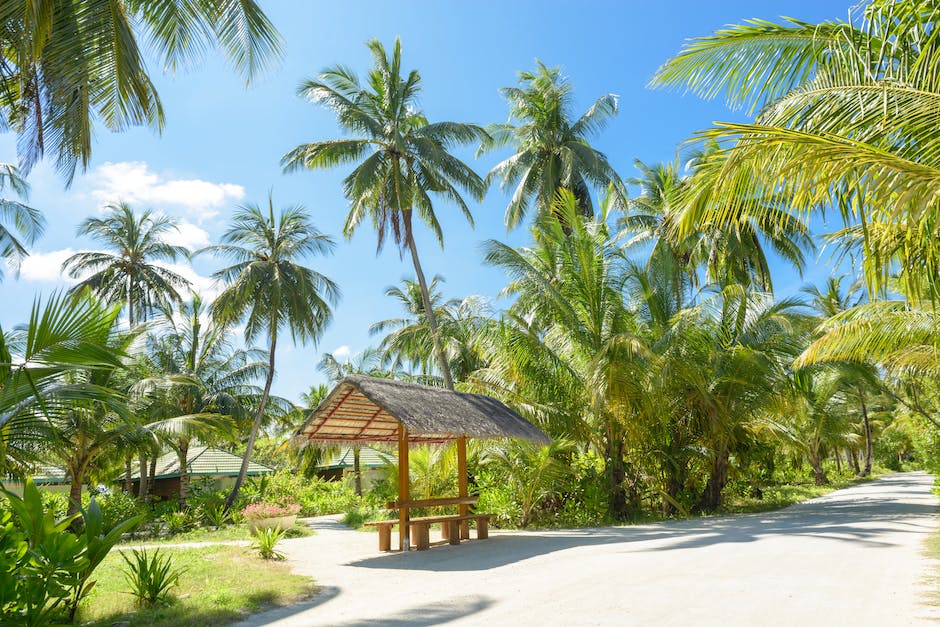Most palm trees do not bearing coconuts. Coconuts are actually a type of drupe, or stone fruit, and they grow on a select few species of palm trees, including the niu, or coconut, tree. Coconut palms grow in tropical regions around the world, such as Southeast Asia, the Indian subcontinent, northern Australia, and central and South America.
No, not all palm trees bear coconuts. There are many varieties of palm trees, and only some of them produce coconuts.
Do some palm trees not grow coconuts?
The Coconut Palm Tree, which just so happens to be the most grown palm tree in the world, is the only species to produce coconuts. Coconut palms are grown in tropical climates all around the world, and they’re an important source of food and income for many people. Coconut palms are tall, slender trees that can reach up to 30 meters in height. They have long, curved leaves and a thick trunk that is covered in a brown, fibrous bark. The coconuts that these trees produce are large, round, and have a hard outer shell that is covered in a brown, hairy husk. Inside the coconut is a white, fleshy meat that is rich in nutrients and water. Coconuts can be eaten fresh or used to make a variety of food and beverage products, including milk, oil, and water.
One of the most obvious differences between coconut trees and palm trees is the presence of fruit. All coconut trees grow coconuts, but not all palm trees produce fruit. This is because coconuts are classified as a drupe, which is a type of fruit that has a hard outer shell that encloses the seed. In contrast, palms are classified as monocots, which means they typically do not produce fruit.
Why don’t I see coconuts in palm trees
If you’re ever in doubt whether a palm is a coconut palm or not, look for these key characteristics: a single unbranched trunk, pinnate leaves, and of course, coconuts!
If you’re patient and willing to wait a few years, you’ll be rewarded with a coconut palm that produces fruit faster than most trees! In just 6-10 years, your coconut palm will start bearing fruit, and will reach peak production in 15-20 years. So, if you’re looking for a long-term investment that will eventually yield tasty rewards, a coconut palm is a great choice!
What is the difference between a palm tree and a coconut palm tree?
A coconut tree is a type of palm tree that can bear coconuts. There is only one species of palm tree that can bear coconuts, but there is a large variety of different coconuts. These varieties can be divided into two main types: Tall and Dwarf.
Pineapples are a type of fruit that is grown from the center of a leafy plant. They are an aggregate fruit, which is formed from a cluster of flowers, or inflorescence. Pineapples are a popular fruit that is used in many different dishes and desserts.
Is a coconut palm the same as a coconut?
Coconuts come from one of the most famous and useful palms in the world, the coconut palm. An iconic symbol of the tropics, the coconut palm can live up to 100 years in the wild. The coconut palm is an important food and economic crop in many tropical countries. The palm produces a large, round fruit that is packed with a white, fleshy interior. The flesh of the coconut is a popular food item and the water inside the coconut is a refreshing drink. The hard shell of the coconut can be used to make bowls, cups, and other household items. The leaves of the coconut palm can be used to make baskets and roofing materials. The palm tree itself can be used for timber. In addition to being a useful plant, the coconut palm is also a beautiful landscape tree.
I hope to find a new home for my coconut palms soon. It’s just too dry here and the temperature range is too wide. Coconut palms do best when the year-round temperature is above 70. That’s no problem most of the year, but our winters, while delightful for us, aren’t healthy for coconuts. Rain is a bigger problem.
Why are there no coconut trees in Australia
The coconut (Cocos nucifera L) is not considered to be a native species in Australia due to the belief that the early European sea captains and botanists did not find coconut trees during their travels to and from Australia. This however, is not completely accurate as there is evidence that coconuts were found in Australia prior to the European settlement. A detailed study of the history of the coconut in Australia is beyond the scope of this note, however, it is evident that the coconut has a long and varied history in Australia that is not well known.
The coconut tree is an important tree in many cultures. It is used for food, building materials, and even as a source of fuel. Coconut oil is used in many products, including cosmetics and cooking oil. The tree is also used in traditional medicine.
Why are there no coconuts in Hawaii?
While coconuts grow throughout Hawaii, the plant didn’t originate here. Instead, coconut plants were first cultivated in two separate places, which makes the coconuts found on islands in the Pacific Ocean different from those found on islands in the Indian Ocean.
Palm trees have relatively short lifespans, except for the date palm which can reach 200 years of age in some cases. The areca palm has a fairly short lifespan of 40 to 50 years, while the popular coconut palm lives between 70 and 100 years, and most date palms hang on for 100 to 120 years.
How often do palm trees produce coconuts
Once they are fully ripened, the coconuts drop to the ground. A typical coconut harvest is every 23 days, equating to 15 harvests a year. One coconut palm tree produces 15 coconuts per harvest, the equivalent to 150 coconuts per tree, per year.
There seems to be some confusion about where coconuts and dates come from. Coconuts and dates grow on palms, not banana trees. Bananas are a type of fruit that grows on a different type of tree altogether.
Why coconut tree is not a tree?
The coconut palm is a monocotyledon, which means that it has only one main leaf growing from each node on the trunk. The trunk of the coconut palm is thick and ringed with Leaf scars. There is no branches or secondary growth. The leaves are star-shaped, and the flowers are white. The fruit of the coconut palm is a drupe, and the innermost layers of the fruit are edible.
According to botanists, trees are defined as woody plants with secondary growth. Palms lack secondary growth and wood, but they create their tough, wood-like epidermis through primary thickening and lignification. Therefore, according to the botanical definition, palms are not trees but large, woody herbs.
Are there two different types of palm trees
Wow, there are a lot of palm tree species! I had no idea. I guess it makes sense though, given that they’re such a staple in tropical and subtropical areas. It’s really neat to think about all the different types of palm trees out there.
Bananas are one of the most popular fruits in the world. They are sweet, nutritious, and easy to eat. Bananas grow in hot, tropical climates. The plant looks like a tree but is actually a giant herb related to lilies and orchids. The plant grows from a root clump (rhizome), similar to a tulip bulb.
Do oranges grow on trees
Oranges are a type of citrus fruit that is typically round in shape and ranges in color from orange to yellow-orange. The flesh of the orange is juice-filled and contains small, edible seeds. The peel of the orange is thin and can be eaten, but is often discarded. Oranges are a popular fruit due to their sweetness and nutritional value, which includes vitamin C, fiber, and antioxidants.
Strawberry tree (Arbutus unedo) is an evergreen tree that bears small, red fruits resembling strawberries. Although they’re not the familiar fruit of shortcake fame, sometimes strawberries grow on trees. The fruits of the strawberry tree are edible, but not as sweet as traditional strawberries.
Why do coconuts have 3 dots
The three holes in a coconut are the result of the three carpels in the coconut flower. This is typical of the family Arecaceae, or palms. The holes are actually germination pores, with one usually functional and the other two plugged. The new coconut shoot will emerge from the functional, open, germination pore.
Coconut sugar is a type of sugar that is made from the sap of coconut palm trees. It is basically the same as palm sugar and jaggery, which can be made from either palm sap or sugar cane. Coconut sugar has a strong caramel taste and is brown in color. It is produced in the Philippines and other parts of South East Asia.
Is a palm tree seed a coconut
The coconut tree is a member of the palm tree family and the only living species of the genus Cocos. The term “coconut” can refer to the whole coconut palm, the seed, or the fruit, which botanically is a drupe, not a nut.
It is clear that palms are not as effective at sequestering carbon as other types of trees. Therefore, it may be best to choose other types of trees when looking to reduce atmospheric carbon.
Why are there no palm trees in Canada
Palms are able to photosynthesize and grow within a specific temperature and humidity range. If the temperature falls below this range, the cells in the palm’s leaves (chlorophyll) will stop photosynthesizing and eventually die.
As a result, you’ll only find a few palm trees growing in Houston. If you’re looking for a place to see palm trees, you’ll need to travel to a warmer climate such as Florida or California.
Where is the coconut capital of the world
Kerala is truly a land of delectable food and hospitable people. For centuries, traders from all over the world have been coming here in search of spices, and they have always been received with open arms and warm hearts. The food of Kerala is as varied as its people, and there is something for everyone to enjoy. Whether you’re looking for a light snack or a hearty meal, you’ll find it here. And don’t forget to try the delicious local spices!
Coconuts are a type of fruit that grow on palm trees. They are picked when they are ripe and are often used in cooking, especially in tropical countries.
It is thought that coconuts were introduced to New Zealand by Polynesian settlers, but they probably disappeared from the country during the glaciation that started about 5 million years ago. This is because coconuts need warm temperatures to grow, and New Zealand became too cold during this period.
However, coconuts are now grown in some parts of New Zealand, such as the Bay of Plenty, where the climate is warm enough.
Final Words
No, all palm trees do not bear coconuts.
No, all palm trees do not bear coconuts. There are many different types of palm trees, and they all produce different fruit. Coconuts are only found on certain types of palm trees.
Jackson Hill is a passionate arborist with years of experience in the field of trees. He developed his fascination with trees at a young age, spending countless hours exploring the forests and climbing trees. Jackson went on to study arboriculture and horticulture at Michigan State University and later earned a degree in forestry from the University of Michigan.
With his extensive knowledge and expertise, Jackson has become a trusted authority on trees and their impact on the environment. His work has helped shape the field of arboriculture and he continues to be a leading voice in the industry.
